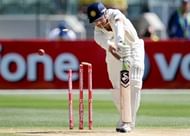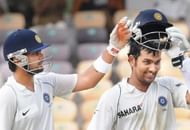Last week, I was watching the dying moments of Perth test in utter disbelief. Yesterday, I woke up early to watch Australia register a famous subjugation on the visitors. For the eighth time in a row, this Indian cricket team which had learnt to fight out of their skins, had encountered meek surrender. The one-man show, the bicycle effect, the inconsistent lengths from bowlers, the flashy strokes away from the body outside off stump have all crept into the team once again. It was a blast from the past. For many, like me, who grew up watching India play abroad in the 90s, the recent development was rekindling the haunting losses India had faced then.
A look at the big picture gives us harsh facts that we have to accept. The failure of this Great Indian batting line up was an accident waiting to happen. The fact that the team was not renowned for world class bowlers to threaten the opposition was always going to hit the team hard, especially in times such as this. Take this for example – India’s fourth best seamer bowls at 125 kph. The ball touches the ankle of MS Dhoni at WACA. India’s rise to Numero Uno in test rankings will mainly be attributed to the batsmen from the golden generation and to an extent the lone warrior with the ball, Zaheer Khan.
THE AGEING MIDDLE ORDER
Let us accept the fact the trio are ageing and surely, they are not at their best now and it is not lying ahead of them. Adelaide test results (in the first innings) supports my theory here. They’re in their twilight of their test careers. The promise was there. And nothing more than mere promise! Sachin Tendulkar promised to deliver the hundredth hundred every time he walked in and found himself in precarious positions either because he lost partners at the other end regularly or because he went into sleep mode for reasons unknown. Dravid’s second wind also promised to deliver more. The English summer brought back memories of vintage Dravid from 2002- 03. He wasn’t falling over while playing the flick and the forward motion was poetic every time he put his front foot in line with the ball to play those exquisite cover drives. His quick hands were at work with the square cuts against the rising delivery. He was batting on a different wicket in England, while everyone else looked all at sea. The Very Very Special of Indian cricket promised to haunt the Aussies once again. He said, he relished batting on Australian wickets. The promise!
When on song, India’s batting order can be compared with the best ever batting line ups to have graced Test cricket till date. But in turmoil, you find them to fall like nine pins. They’re generally together even with failures. They strike hot form in unison or fall flat together at once. Tendulkar’s dramatic turn-around (recently) with the series of resplendent performances juxtaposed with Gambhir’s rise in world cricket as Test opener. Laxman was the magician who stroked his wand like no one else. Sehwag had the odd sparkle and miracle. Dravid was the only one who looked out of sorts for most part in the last two years. But even he produced quite a handful of memorable acts.
Success and failure go hand in hand for sportsmen. Even the mighty Windies had a great fall. We saw how Australia were demolished not once but twice by England in two years. It touches upon the philosophical territory, moment we get into success and failure. The fans, who form the real base for the sport, at least want to see some fight even if you lose. The Kohli-Saha partnership in Adelaide was a rare show of that attitude on the field by Indians in Australia. No one questioned you for the losses in Australia during the last tours. So what’s the difference now? Meek surrender!
India didn’t have injuries to deal with during the tour or during the test matches, unlike England. Well if that was one reason to lose in England, can the team give any reasons for this embarrassment down under? It has to boil down to the inept batting sans temperament on bowler friendly surfaces. We might find it embarrassing, but Ashwin regards this only as extreme disappointment.
Somehow the criticism of India’s golden trio isn’t going to work in favor of them. They’ve to choose how their Test careers are going to pan out. The selectors have to plan the way to phase them off. India aren’t playing a Test series for the next six months which in effect is going to take six more months out of a certain Laxman and Dravid. The next tour away from sub-continent will happen in December 2013. Many of us can bet that Laxman and Dravid will not be part of that touring squad. The gap is long enough to make them rusty. Do you think there is lot of cricket really left in them to make an impact in Indian cricket? Can Laxman really revive India’s chances once again like he did in 2001? Do you really expect any more magic from the magician? I’m afraid, I have “NO” as the answer for all these questions!
The big middle order failure has taken another important trouble, the Indians are facing these days. The batting form of Gautam Gambhir and Virender Sehwag. Opening partnership is a very crucial part and in many cases, backbone of huge scores in test cricket. Each time India has lost a test in England and Australia in the 8 months, they’ve failed to strike an opening partnership. The word “woeful” might suit their current state of mind. Gambhir has had a torrid time in Australia. Except for the 80-odd, he scored in Sydney, Gambhir has never looked settled even if he has faced more than 50 balls. Sehwag’s style of batting will have to come under scrutiny some day. His shot making was reckless in the 2nd innings at Adelaide. Apart from that, he looked a batsman lost in mind completely. Soft dismissals must have left his fans stunned. He seldom moves his feet. But, neither his bat moved much. The swing from Hilfenhaus did him in consistently throughout this season.
THE FUTURE?
Who is India’s future? Rohit Sharma or VVS Laxman? Sachin Tendulkar or Virat Kohli? Rahul Dravid or Cheteshwar Pujara? Do a certain Rohit Sharma, Virat Kohli and Cheteshwar Pujara have their best years of cricket coming up? If the answer is yes, the real way forward from here then is to blood in youngsters. Virat Kohli has made a case for himself after this special hundred at Bradman’s home. Kohli was the batsman whose head was waiting to be chopped after the Sydney Test. Now he remains the lone centurion for India in this tour. The trio have gained a lot of respect that they can choose their way out of Indian cricket and I believe they’ve earned that! But that shouldn’t hamper the team’s progress.
A young Tendulkar made the world stand up and take notice when he scored a hundred on a bouncy Perth wicket. A 23-year old Dravid came to the fore in 1996, when he made tons in England. Sourav Ganguly on debut, brought down Lords’ with one of his finest hundreds till date. VVS Laxman stroked his future in Sydney to enchant everyone with a career-defining 167 in 1999-00. Virender Sehwag smashed the leather in the middle order at Bloemfontein against the South Africans. He later impressed one and all as a Test opener in England. What’s common in all these cases? Success abroad as batsmen!
As long as the million dollar babies of today in Indian cricket keep playing on flat beds at home be assured that they’d never grow. The cricket calendar isn’t going to help them flourish abroad either. Until the end of December 2013, India are going to stay at home and these two years aren’t going to mean much to the growth of young India. By the time December 2013 comes, we would have forgotten all our embarrassments we’ve suffered and bask in the glory of convincingly thrashing teams in our own den.
The board has, thankfully, realized the importance of A-tours. For a few years now, the A-tours weren’t happening and the only time the top domestic cricketers get to play abroad in bowler-friendly conditions is at the Emerging Players tournament. The selection for Emerging Players tournament raised a few eye-brows with the IPL stars finding a place to play the long version of the game. I hope the IPL doesn’t become the criteria to select the best cricketers for such tournaments. It gets extremely important for the future India cricketers to get a feel of the conditions abroad. But would that only be enough? The change should happen right from the root. Aakash Chopra recently tweeted, “The quality of cricket and cricketers we produce is directly proportionate to the quality of surface we prepare.” This Ranji season has seen extremes ! While a Ranji semi final got over in just over two days, the final saw Rajasthan bat the first innings for three days.
Forget the defensive attitude the Rajasthan batsmen displayed during the final. To an extent, the rules in the system make teams to play for the first-innings lead. The pitch that was used for the most important domestic final was poor to say the least. Dinesh Karthik went on to add, he would have preferred to play in Mumbai or Baroda (which according to him has a result oriented track) rather than in Chennai, which neither supported the fast bowlers nor the spinners. Change has to start here. If India’s fortunes have to change, such tracks can’t have a place in our cricket.
A lot of chatter has also been about India’s athleticism on the field. How can we even forget Nasser Hussain’s comments that created so much furore back home during the England tour? With my first hand experiences in the first division games played in Mysore, I can assure you that not much has gone to the roots of Indian cricket to develop athleticism. Fielding will remain a disappointing aspect of Indian cricket until the grounds aren’t improved. Some of the grounds here in Mysore and Mandya have extremely poor outfields that no one can even think of diving around. When this is the case with Tier-II city in India, I can leave it to your imagination to assume the state of the facilities that first division teams would get at other places in the country.
The importance of playing the longest format of the game is also lacking in many parts of the country. The losses in England and Australia have somehow got more limelight on test cricket than ever before. KSCA came up with revamping junior level cricket, about a year ago. Now, Punjab Cricket Association have banned IPL for its local cricketers until they are 21. More importantly, even they are going back to the drawing board to focus on three and four day cricket matches. Its just the right direction, state associations have to go forward.
As Harsha Bhogle pointed out, the change has to be effective and shouldn’t be superficial simply because Indian teams till date haven’t showed the ability to beat Australia in Australia and South Africa in South Africa. The day, an Indian team wins test series in foreign soil (especially in Australia, England and South Africa) you can proudly claim that the change has had its effects. The change, we hope, begins as early as possible.
Looking for fast live cricket scores? Download CricRocket and get fast score updates, top-notch commentary in-depth match stats & much more! 🚀☄️



